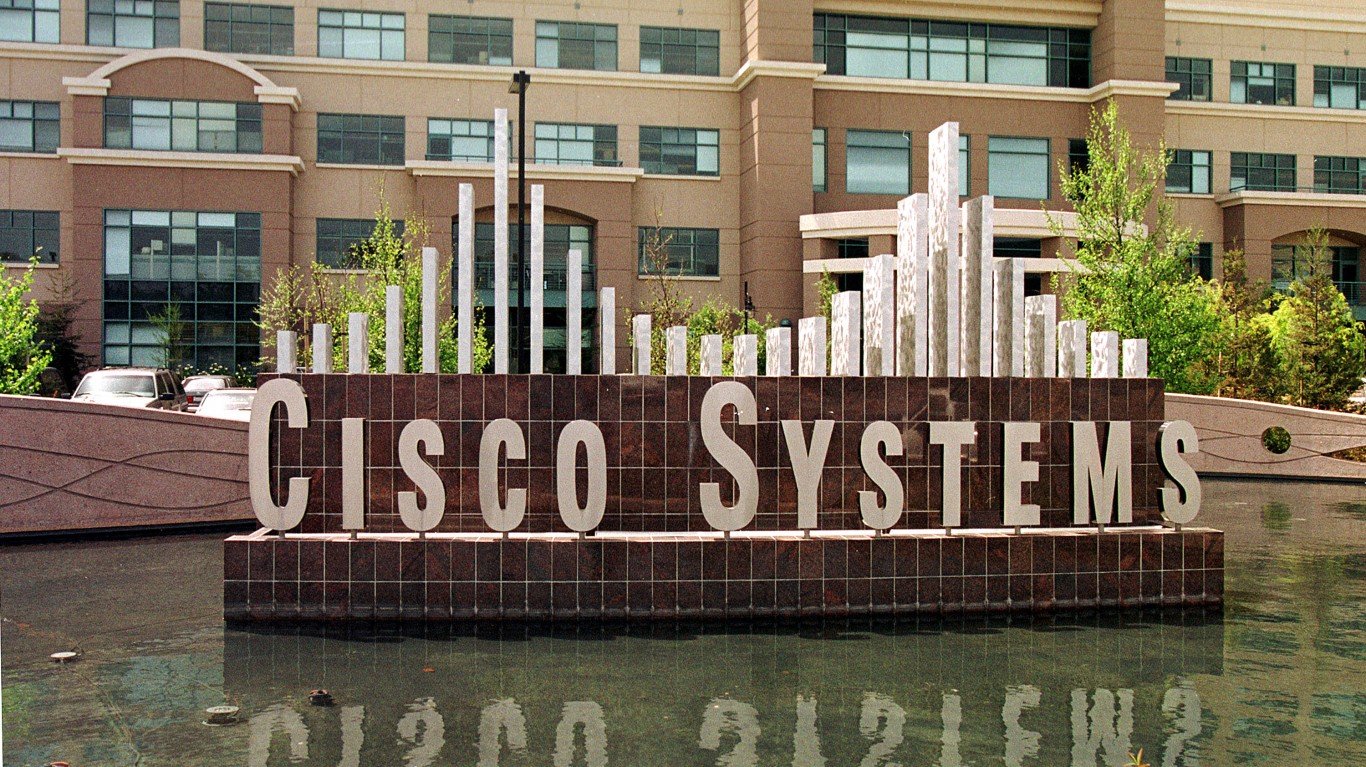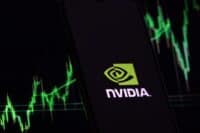

Cisco Systems Inc. (NASDAQ: CSCO) has acted like a champ in 2019. Its shares were up about 30% year to date, one of the top stocks in the Dow Jones industrial average. Its shares have recently hit multiyear and decade highs, while the Dow, S&P 500 and Nasdaq 100 have all achieved all-time highs. With a changing business model in recent years, Cisco is finally living up to its status as a stock to own for a decade. The question now is whether Cisco is a stock to own for the next decade.
24/7 Wall St. first named Cisco to a list of 10 stocks to own for the decade way back in November of 2010. With a new decade approaching, it is important to look backward for reflection and to look forward for guidance and planning. Without adjusting for dividends, Cisco was trading at close to $24.25 when we named it a holding for the decade. There is a history about why looking out for a decade doesn’t have to bring immediate action for investors when the market is at all-time highs. With some very (un)lucky timing in late 2010, Cisco shares immediately took it on the chin with a very bad earnings report right after it was featured as a decade-long holding in 2010.
What helped make Cisco a stock to own for the next decade in 2010 was that it was just about to become a dividend paying stock, and a lot of industry and companywide changes seemed to be brewing. It was also a time when much of the public was only just starting to recover from the Great Recession. U.S. unemployment was well over 9% at that time, and U.S. gross domestic product of almost $15 trillion is far shy of the current $21 trillion GDP of 2019.
With a recent share price of $57.25, there has been a simple gain of about 135% in nearly nine years. If you add in the total $7.00 or so that Cisco has paid in dividends per share since 2011, without even factoring in reinvestment, Cisco’s total return would be closer to 200% since 2010.
While a total return of that size should be nothing to be unhappy about, the current bull market is over 10 years old. The S&P 500 was at 1,219 and the Dow was only 11,350 back in late 2010. Those indexes now are closer to 3,000 for the S&P 500 and almost 27,000 for the Dow. Of those picks for the decade versus today, one has tanked and been a disaster, two would be classified as “nothing burgers” and seven have risen substantially (some seeing exponential gains).
Picking a stock to own for a decade will have vastly different criteria in 2019 or 2020 than way back in 2010. In 2010, the goal was not trying to pick the best performers of the market. It was a different time with much more market and investor unease from the effects of the Great Recession. The goal back then was to pick solid companies that either paid dividends or were about to, as well as companies that had the opportunity to keep raising their dividends or buying back stock or would be acquirers of other companies. It was a time that there was no assurance the bull market from that V-bottom in March 2009 would keep recovering. Many pundits were still sure that a bear market and recession were around the corner. For a serious market reminder, note that the S&P 500’s peak in 2007 was not even recaptured until early in 2013.
Cisco can still fit in as a stock to own for the next decade for many investors. There are some caveats of course, and some investors rightfully will wonder if there are better opportunities than Cisco. In order even to qualify as a stock to own for the next decade, a company has to pay a stable or growing dividend, with basic earnings predictability and ongoing market opportunities ahead. That automatically screens out many of the high-flying companies like Amazon, Alphabet, Facebook, Netflix and so on that have greatly outperformed Cisco in the past decade.
Where things stand now is that Cisco is under an entirely different leadership team. It’s now a Chuck Robbins company top to bottom, and it has been restructured handily since John Chambers ran the company. While Cisco has been changing its model, the company has only grown annualized revenues from $40 billion to about $50 billion as of last look. That is not exactly barn-burning growth, to put it nicely.
Another issue to consider is that Cisco is one of the few tech giants from the dot-com era stock market bubble in 1999 and 2000 that has still not even reached its all-time high. And with a current market cap of about $245 billion, Cisco has spent somewhere close to $80 billion in share buybacks during the past decade alone.
One issue that makes it quite difficult to value Cisco’s future from today, and versus 10 and 20 years ago, is that Cisco keeps making acquisitions that range from bolt-on deals to upstarts that can be rapidly expanded by its team. This is a time when selling routers, switches and core web traffic equipment has changed greatly from Cisco’s meteoric rise during and after the 1990s.
As of April 2019, Cisco listed its balance sheet “goodwill” as more than $33.5 billion. Just some of Cisco’s big acquisitions over time have been Scientific Atlanta for almost $7 billion, WebEx for about $3 billion, Sourcefire for more than $2 billion, AppDynamics for over $3 billion, Broadsoft for almost $2 billion and the most recent, Acacia Communications for about $2.7 billion. Cisco’s full list of acquisitions over time has been too vast to fathom, and many of the efforts made back then are not even part of the real mix today.
Despite Cisco having exponentially raised its dividend payments from a decade ago, its yield of 2.50% at the current time is only in the middle of the pack for Dow Jones industrials. Cisco’s $1.40 annualized dividend per share payment is also not even quite half of its expected current year’s $3.08 in adjusted earnings per share.
Cisco still dominates in the world of networking and communications markets, but by adding more security, services and recurring revenues the company is now no longer beholden only to new equipment sales and upgrades. Cisco will continue to buy back shares and easily has room to grow its dividend ahead. Wall Street seems to think that sales growth will be in the mid-single digits for the years ahead, which may not be aggressive compared to likes of Amazon, Alphabet and other tech giants. Still, it might be another decade before the fast growth stocks of the past decade even decide to start paying out dividends.
Cisco is not alone in the technology world of having long-term debt. That face value was $16.6 billion in long-term debt as of early 2019, but that is down handily from the $25-plus billion in long-term debt just two years ago.
Trading at $57.25 currently, Cisco shares have a 52-week range of $40.25 to $58.15. The Refinitiv consensus analyst target price of $58.75 today implies only modest upside. Many analysts are still quite neutral on Cisco as well, with formal price targets that are under the current share price. Some exceptions are Goldman Sachs ($62), Merrill Lynch ($62, with potential upside), UBS ($61), Cowen ($65) and Raymond James ($60).
Many investors are going to think that Cisco is too boring today to own for the next decade. That said, the bull market is now well into its 10th year, and the media keeps reminding the public about how soon that next recession may come. Cisco obviously is not the same growth engine it was 20 years ago, nor will it ever likely be again. While it is a slower revenue grower than the top tech giants as we near 2020, Cisco has $35 billion in cash with a declining long-term debt load. It has averaged over $13 billion in annual cash flow from operations. It has raised its dividend and bought back boatloads of stock, and it likely can keep raising its dividend and committing more for buybacks. Cisco also likely will keep making opportunistic acquisitions.
Cisco’s current valuation is now about 18 times expected earnings, which is a slight premium to the market after years of trading at discount. With lower growth expectations, many investors may choose to wait to own Cisco until the next time the stock gets crushed after earnings or in a market sell-off.
With the bull market and economic expansion a decade old now, it seems more than reasonable to expect that one recession (and maybe even two) will have been seen by the time 2029 and 2030 arrive. There will be three presidential elections between then and now, and the balance of power in Congress may have shifted once or twice more. It also seems likely that the tax code might have some changes over the next decade.
It does not seem realistic to expect that the total stock market growth will be 350% over the next decade as it has been over the past decade from that V-bottom in early 2009. Much of the next decade’s total performance also may depend on how much the next equity market sell-off will be, if and when that next recession ever arrives. There is even the endless growth of government debt in the developed nations that has to be considered (like $16 trillion in federal U.S. debt today, or $22 trillion with intragovernmental debt included). In a decade from now, many of the baby boomers won’t just be retiring from work, they will be permanently checking out.
There are many pros and cons that investors can use in evaluating Cisco looking a decade out to 2029 or 2030. As of 2019, it seems that Cisco is here to stay and the 54-year old Chuck Robbins and his future successor(s) are probably going to make whatever moves they deem necessary to keep Cisco relevant and profitable over the next decade while still keeping with the company’s tradition of aggressively returning capital to shareholders.
It would be hard (and maybe even impossible) to just assign a $100 price target on Cisco out to 2029 or 2030. There are too many unknowns. Some of those unknowns could even make the next decade a total financially round-trip to nowhere. That said, long-term investors have to consider Cisco’s future beyond 2020, beyond the next election and even beyond the next business cycle. It is also not set in stone that Cisco will be a winner in the next decade. If things remain even close to what they have been over the past decade, it seems very reasonable to expect that Cisco will have paid out $20 or more in dividends and spent billions more on buybacks over the next 10 years.
Sponsored: Want to Retire Early? Here’s a Great First Step
Want retirement to come a few years earlier than you’d planned? Or are you ready to retire now, but want an extra set of eyes on your finances?
Now you can speak with up to 3 financial experts in your area for FREE. By simply clicking here you can begin to match with financial professionals who can help you build your plan to retire early. And the best part? The first conversation with them is free.
Click here to match with up to 3 financial pros who would be excited to help you make financial decisions.
Thank you for reading! Have some feedback for us?
Contact the 24/7 Wall St. editorial team.
 24/7 Wall St.
24/7 Wall St. 24/7 Wall St.
24/7 Wall St.


